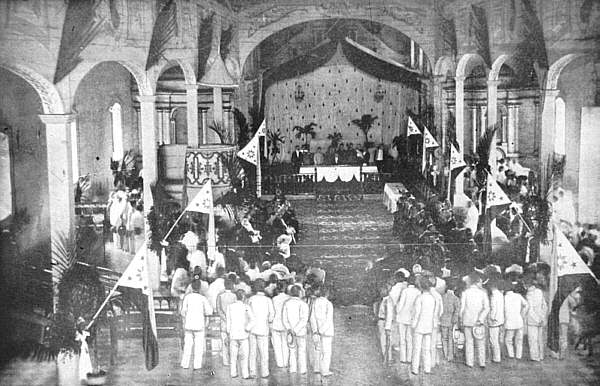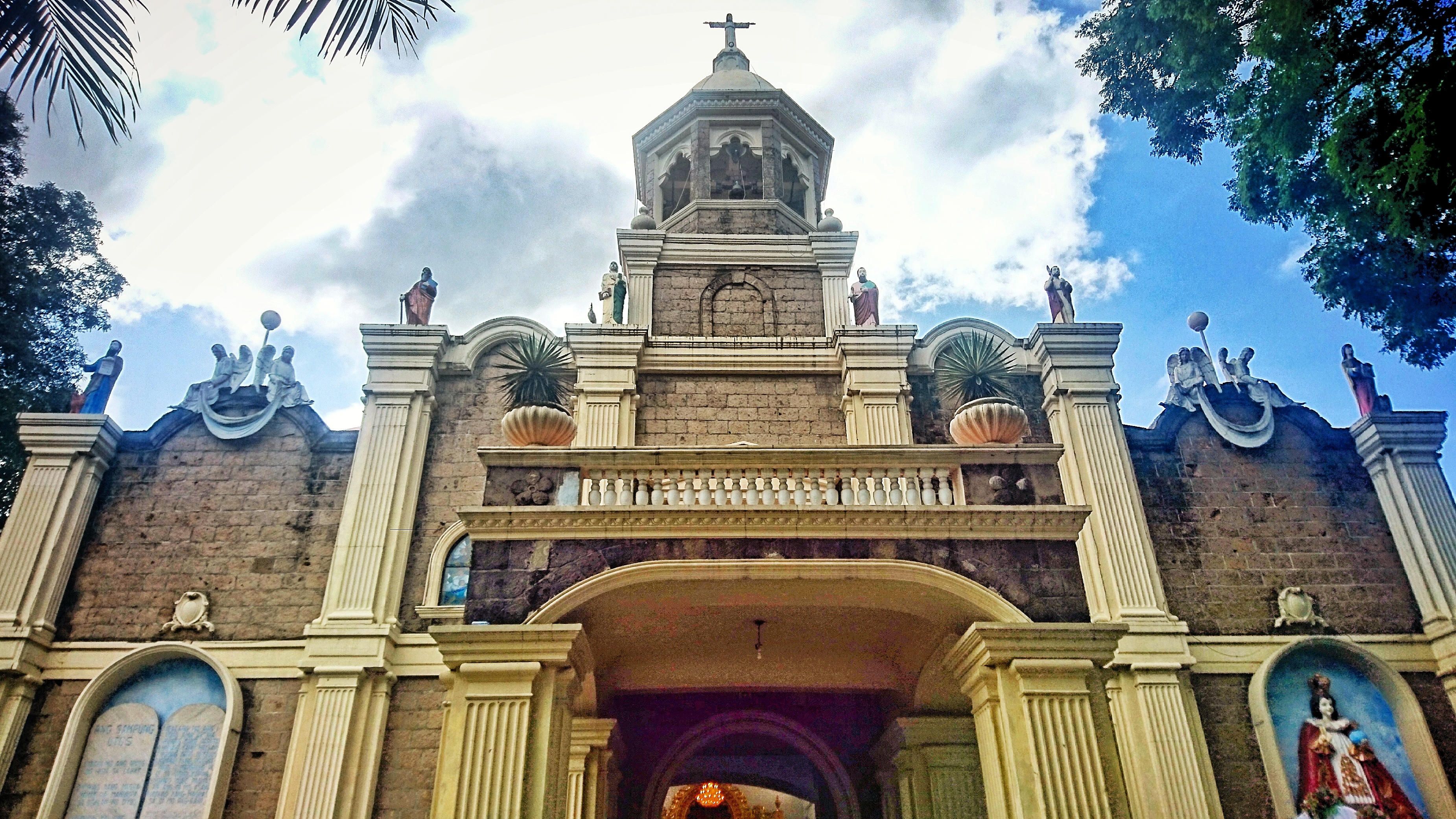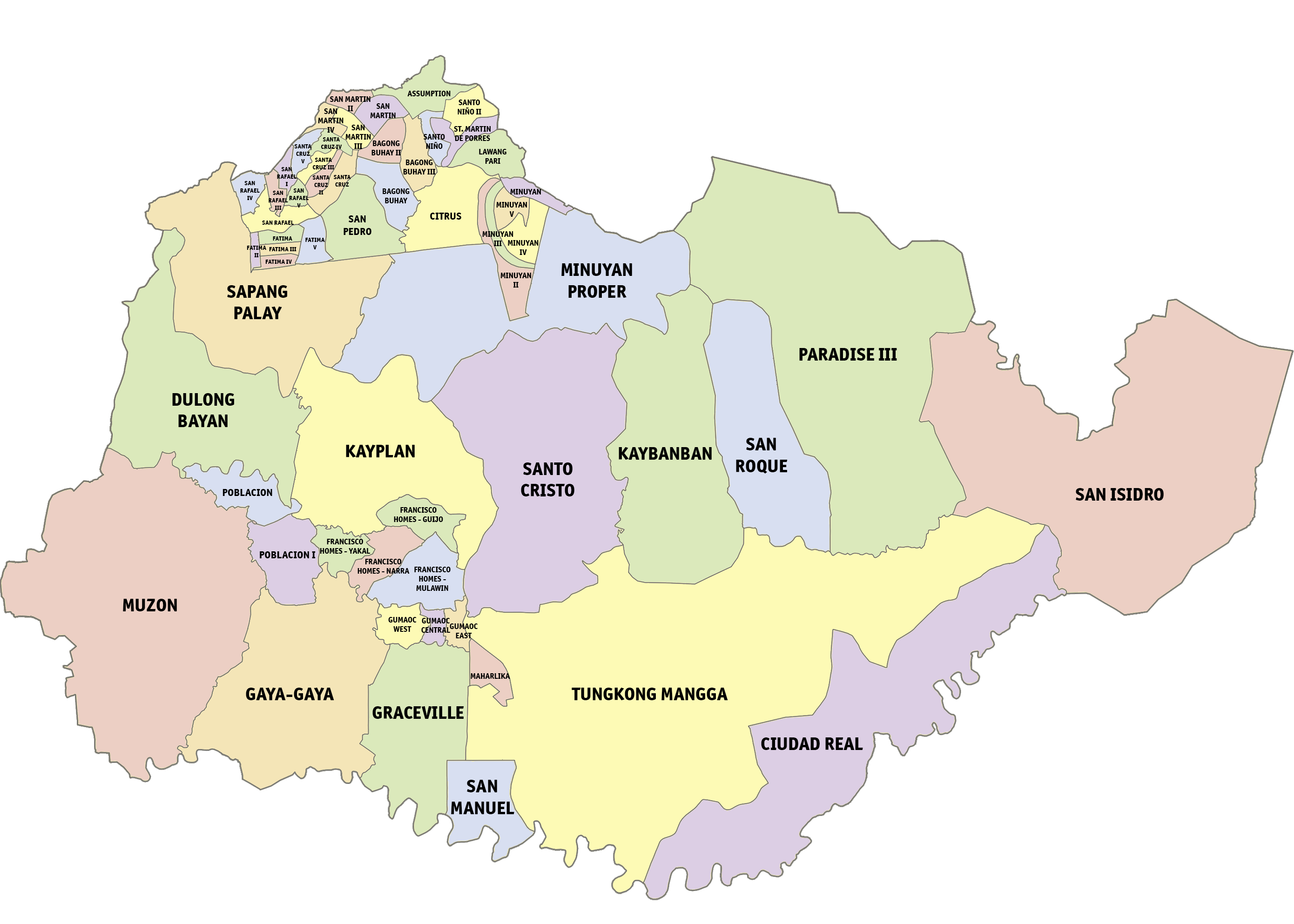|
Bulacan Province
Bulacan, officially the Province of Bulacan ( tl, Lalawigan ng Bulacan), is a province in the Philippines located in the Central Luzon region. Its capital is the city of Malolos. Bulacan was established on August 15, 1578, and part of the Metro Luzon Urban Beltway Super Region. It has 569 barangays in 20 municipalities and four component cities (Baliuag, Malolos the provincial capital, Meycauayan, and San Jose del Monte). Bulacan is located immediately north of Metro Manila. Bordering Bulacan are the provinces of Pampanga to the west, Nueva Ecija to the north, Aurora and Quezon to the east, and Metro Manila and Rizal to the south. Bulacan also lies on the north-eastern shore of Manila Bay. In the 2020 census, Bulacan had a population of 3,708,890 people, the most populous in Central Luzon and the third most populous in the Philippines, after Cebu and Cavite. Bulacan's most populated city is San Jose del Monte, the most populated municipality is Santa Maria while the least po ... [...More Info...] [...Related Items...] OR: [Wikipedia] [Google] [Baidu] |
Barasoain Church
Barásoain Church (official title: Our Lady of Mount Carmel Parish) is a Roman Catholic Church, Roman Catholic church (building), church built in 1888 in Malolos City, Malolos, Bulacan. It is about 42 kilometers from Manila. Having earned the title as the "Cradle of Democracy in the East, the most important religious building in the Philippines", and the site of the First Philippine Republic, the church is proverbial for its historical importance among Filipino people, Filipinos. Etymology The name "''Barásoain''" was derived from Barásoain in Navarre, Spain, which the missionaries found to be strikingly similar to the place in Malolos. When the Philippine Revolution broke out, Spanish authorities coined the term "''barás ng suwaíl''“ (Tagalog language, Tagalog, “dungeon of the defiant”) because the church was a meeting-place for anti-Spanish and anti-colonial ''illustrados''. History Barásoain was originally known as "''Bangkál''“, a part of Encomienda of Malo ... [...More Info...] [...Related Items...] OR: [Wikipedia] [Google] [Baidu] |
Cities Of The Philippines
A city ( fil, lungsod/siyudad) is one of the units of local government in the Philippines. All Philippine cities are chartered cities ( fil, nakakartang lungsod), whose existence as corporate and administrative entities is governed by their own specific municipal charters in addition to the Local Government Code of 1991, which specifies their administrative structure and powers. As of December 17, 2022, there are 148 cities. A city is entitled to at least one representative in the House of Representatives if its population reaches 250,000. Cities are allowed to use a common seal. As corporate entities, cities have the power to take, purchase, receive, hold, lease, convey, and dispose of real and personal property for its general interests, condemn private property for public use (eminent domain), contract and be contracted with, sue and exercise all the powers conferred to it by Congress. Only an Act of Congress can create or amend a city charter, and with this city charter Cong ... [...More Info...] [...Related Items...] OR: [Wikipedia] [Google] [Baidu] |
Guiguinto, Bulacan
Guiguinto, officially the Municipality of Guiguinto ( tgl, Bayan ng Guiguinto), is a 1st class municipality in the province of Bulacan, Philippines. According to the 2020 census, it has a population of 113,415 people. Guiguinto is one of the fast-growing municipalities. From a predominating agricultural economy, it gradually urbanized and developed, now part of the Metro Manila conurbation. Guiguinto is from Manila and from Malolos City. It is the birthplace of composer Constancio De Guzman, known for writing songs like "'' Maalaala Mo Kaya''". It also houses the Immaculate Conception Seminary, a Diocesan Seminary of the Diocese of Malolos located in barangay Tabe. The appellation “Guiguinto” literally translates to “Gold” for the early conquistadores came and saw this town on a harvest season when it lushes in golden rice stalks against the sun. History Guiguinto began as a barrio of Bulakan, the former provincial capital of Bulacan. It is said that Spaniards set up ... [...More Info...] [...Related Items...] OR: [Wikipedia] [Google] [Baidu] |
Doña Remedios Trinidad
Doña Remedios Trinidad, officially the Municipality of Doña Remedios Trinidad ( tgl, Bayan ng Doña Remedios Trinidad), is a 1st class municipality in the province of Bulacan, Philippines. According to the 2020 census, it has a population of 28,656 people. It is known as "Bulacan's Last Frontier" because of its natural environment and as it is the least travelled town in the province. Etymology The municipality of Doña Remedios Trinidad was named in honor of Doña Remedios T. Romualdez, mother of then First Lady Imelda Romualdez Marcos, who was a Bulakeña from the town of Baliuag. History On September 13, 1977, Philippine President Ferdinand Marcos issued Presidential Decree No. 1196 creating the municipality of Doña Remedios Trinidad. The municipality covers seven barangays, originally part of Angat, Norzagaray, and San Miguel. These are Pulong Sampaloc and Camachile of Angat; Bayabas and Kabayunan of Norzagaray; Talbac, Camachin and Kalawakan of San Miguel. Geography ... [...More Info...] [...Related Items...] OR: [Wikipedia] [Google] [Baidu] |
Calumpit, Bulacan
Calumpit, officially the Municipality of Calumpit ( tgl, Bayan ng Calumpit), is a 1st class municipality in the province of Bulacan, Philippines. According to the 2020 census, it has a population of 118,471 people. Etymology The name "''Calumpit''" comes from the tree "'' Kalumpít''", an indigenous hardwood species similar to ''apalit'' and narra, which grows abundantly in front of the St. John the Baptist Parish Church in the Población-Sucol area. History Precolonial era Calumpit was already an established ''barangay'' under the leadership of Gat Maitim prior to the Fall of the Kingdom of Tondo in June 1571. Other nearby villages were Gatbuka, Meyto, Meysulao, Pandukot, Malolos, Macabebe, Hagonoy, and Apalit. When Calumpit was hispanised and established as a political and geographical entity in 1572, they chose what is today Barangay Población as the site of the church and the administrative center of the aforementioned villages, which were annexed to it. Spanish pe ... [...More Info...] [...Related Items...] OR: [Wikipedia] [Google] [Baidu] |
Bustos, Bulacan
Bustos, officially the Municipality of Bustos ( tgl, Bayan ng Bustos), is a 2nd class municipality in the province of Bulacan, Philippines. According to the 2020 census, it has a population of 77,199 people. With the continuous expansion of Metro Manila, Bustos is now included in the Greater Manila's built-up conurbation area which reaches San Ildefonso, Bulacan at its northernmost part. Etymology The town got its name from Jose Pedro Perez de Busto a mining engineer from Villaviciosa, Asturias, Spain, served as the right-hand of Simón de Anda y Salazar, and was appointed ''teniente general alcalde'' (Provincial Governor) of Bulacan. History Bustos was a part of the town of Baliuag as its barrio during the Spanish Period. The town was separated from Baliuag by a tragic incident when around 1860, during a rainy Sunday, a group of natives from Bustos with babies in their arms were on their way to St. Augustine Parish Church of Baliuag for baptismal when they drowned after the ... [...More Info...] [...Related Items...] OR: [Wikipedia] [Google] [Baidu] |
Bulakan, Bulacan
Bulakan, officially the Municipality of Bulakan ( tgl, Bayan ng Bulakan), is a 1st class municipality in the province of Bulacan, Philippines. According to the 2020 census, it has a population of 81,232 people. It is north of Manila. Bulakan, which is one of the oldest towns in the Philippines, became the ''encomienda'' or capital of the '' Provincia de la Pampanga'', and later became the first capital of the Province of Bulacan before it was moved to Malolos shortly after the American occupation. With regards to whether to use the letters "c" or "k" to refer to the municipality of Bulakan, the New Provincial Administrative Code of Bulacan (Ordinance no. C-004) of 2007 states on Chapter 2, Section 15 that the word "Bulakan" stands for the municipality and first capital of the province while "Bulacan" refers to the province itself. Etymology The name "Bulakan" is derived from the Tagalog word "bulak", which means "cotton". The town was named Bulacan due to the abundance of ... [...More Info...] [...Related Items...] OR: [Wikipedia] [Google] [Baidu] |
Bocaue, Bulacan
Bocaue, officially the Municipality of Bocaue ( tgl, Bayan ng Bocaue), is a 1st class municipality of the Philippines, municipality in the Philippine Province, province of Bulacan, Philippines. According to the 2020 census, it has a population of 141,412 people. With the continuous expansion of Metro Manila, the municipality is now part of Greater Manila Area, Manila's built-up area which reaches San Ildefonso, Bulacan, San Ildefonso in its northernmost part. The Bocaue River runs through most of the town. Among its tourist attractions are a town museum located near the municipality's center and the town's river festival celebrated on the first Sunday of every July. The river festival is in commemoration of the Holy Cross of Wawa, believed to be miraculous by the town's predominantly Roman Catholic population. Etymology The town's name comes from the Old Tagalog word "''Bukawe''", which refers to a type of long bamboo (''Schizostachyum lima, Schyzostachyum lima''). History Boca ... [...More Info...] [...Related Items...] OR: [Wikipedia] [Google] [Baidu] |
Balagtas, Bulacan
Balagtas, officially the Municipality of Balagtas ( tgl, Bayan ng Balagtas), is a 1st class municipality in the province of Bulacan, Philippines. According to the 2020 census, it has a population of 77,018 people. With the continuous expansion of Metro Manila, the municipality is now part of Manila's built up area which reaches San Ildefonso in its northernmost part. Balagtas is from Manila and is from Malolos City. Formerly known as Bigaa, it was renamed in honor of Filipino poet Francisco Balagtas. The MacArthur Highway bisects the municipality of Balagtas as this national road cuts northward to the Ilocos region. At the southern approach of the town from Manila is a concrete bridge that crosses the Balagtas River. The river, navigable by banca and motor boats, empties into Manila bay after snaking through the town of Bulacan to the West which provides Balagtas' townsfolk with fish, shrimp, and other fresh water food. At the foot of the bridge, along the highway towards th ... [...More Info...] [...Related Items...] OR: [Wikipedia] [Google] [Baidu] |
Angat, Bulacan
Angat, officially the Municipality of Angat ( tgl, Bayan ng Angat), is a 1st class municipality in the province of Bulacan, Philippines. According to the 2020 census, it has a population of 65,617 people. Etymology The Town of Angat got its name after the Tagalog word ''Angat'' (A-ngat), meaning 'elevated' or 'a high piece of land'. History Angat was originally a part of the Old Pueblo de Quingua, now Municipality of Plaridel. This fact was due most probably to the situation of the Rio de Quingua Angat River, which directly connects the town of Quingua, a community then located in the center of vast lands, covering plains and mountains alike. Augustinian missionaries built a small ''visita'' (chapel) under the Parochial ministry of Paroquia de Santiago Matamoro de Quingua. In 1683 the ''visita'' of Angat made a Town Church and the whole Angat where established as a new Pueblo. Today, still stands and legible, is the inscription at the façade of her church with a Roman Num ... [...More Info...] [...Related Items...] OR: [Wikipedia] [Google] [Baidu] |
Municipalities Of The Philippines
A municipality ( tl, bayan/munisipalidad; hil, banwa; ceb, lungsod/munisipalidad/munisipyo; pag, baley; pam, balen/balayan; bcl, banwaan; war, bungto/munisipyo; ilo, ili) is a local government unit (LGU) in the Philippines. It is distinct from ''city'', which is a different category of local government unit. Provinces of the Philippines are divided into cities and municipalities, which in turn, are divided into barangays (formerly barrios) – ''villages''. , there are 1,488 municipalities across the country. A municipality is the official term for, and the official local equivalent of, a town, the latter being its archaic term and in all of its literal local translations including Filipino. Both terms are interchangeable. A municipal district is a now-defunct local government unit; previously certain areas were created first as municipal districts before they were converted into municipalities. History The era of the formation of municipalities in the Philippines sta ... [...More Info...] [...Related Items...] OR: [Wikipedia] [Google] [Baidu] |
San Jose Del Monte, Bulacan
San Jose del Monte, officially the City of San Jose del Monte (abbreviated as SJDM or CSJDM; fil, Lungsod ng San Jose del Monte), is a 1st class component city in the province of Bulacan, Philippines. According to the 2020 census, it has a population of 651,813 people, making it the largest local government unit within the province of Bulacan and Central Luzon and the 18th most populated city in the Philippines. The City of San Jose del Monte, has proclaimed as a highly-urbanized city on December 4, 2020, by the virtue of Proclamation No. 1057, signed by President Rodrigo Duterte and shall take effect after the ratification in a plebiscite. Located in the southeast of the province, it is bordered by the city of Caloocan in Metro Manila to the south, by the town of Rodriguez, Rizal to the east, the towns of Santa Maria and Marilao to the west and Norzagaray to the north. The city is home to some of the biggest resettlement areas in the Philippines like the Sapang Palay resett ... [...More Info...] [...Related Items...] OR: [Wikipedia] [Google] [Baidu] |








.jpg)
